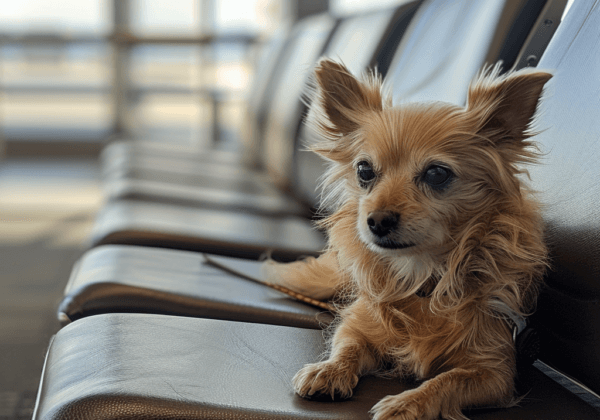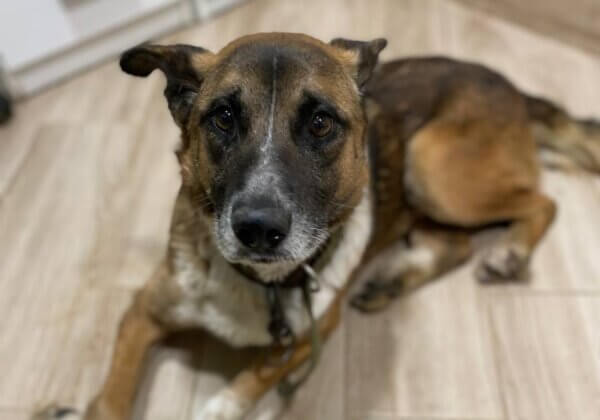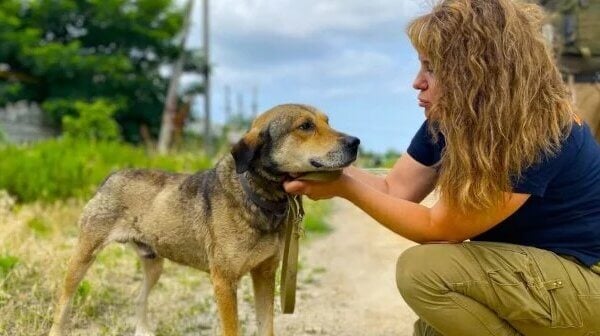My Dog Can’t Walk, Thanks to Fireworks – And We’re Bracing for More on Australia Day
By Amanda Behrmann
Just before Christmas last year in Perth, we were preparing to settle in with our dog, Misty, indoors and safe from the fireworks scheduled to bombard the skies just 15 minutes later – but we were all surprised when the display began early, sending Misty into a confused panic. Normally a homebody, she squeezed herself under the garage door (which is no small feat for the bull Arab or mastiff cross we assume her to be) and zig-zagged down the street in a frenzied attempt to escape the explosions. When my son, who bolted barefoot after her, finally caught up with her five kilometres away, she was wide-eyed and covered with blood. She was so traumatised, she had to be sedated at the emergency veterinary clinic – the first of four visits needed to clean and dress her wounds. Two thousand dollars later, she’s recovering, but we’re all in fear of what will happen when there’s another fireworks display.

For thousands of companion animal–guardians, the threat of fireworks lingers all year round. The next hurdle is Australia Day: just three short weeks after loud explosions lit up our skies to mark 2024, wild and domestic animals will again be confronted with a barrage of blazing lights and thunderous sounds.
One thing firework fanatics tend to forget is that animals don’t know the explosions are meant to be festive. Heck, most animals don’t even know they’re colourful! All they know is that fireworks are sudden, noisy, and glaring intrusions on their safe space – whether that’s the homes they share with their guardians, the trees in which they build their nests, the woodlands where they raise their babies, or in the case of farmed animals, the cages, barns, and other enclosures in which they’re forced to live.
Misty isn’t the first victim of fireworks, and she won’t be the last, and companion animals aren’t the only ones they harm: terrified birds abandon their nests and fly into buildings and other animals flee their burrows or run into traffic. If they never return, their young starve to death. In 2010, a Northern Territory echidna died after a rogue firecracker burned 90% of her body. One of the wildlife carers who tended her lost their own bird companion to a firework-induced heart attack. Dogs have been known to smash through glass doors and sustain injuries when they jump high fences, and the RSPCA reports a considerable increase in lost animal companions after firework displays.
Fireworks are problematic for many humans, too, including those with sensory processing disorders and refugees as well as soldiers and veterans. The fact that over 3,000 indigenous Australians currently serve in the military makes using PTSD-exacerbating explosions to celebrate what led to the genocide of First Nations people more than a little rich. And speaking of rich, the cost to taxpayers, most of whom are far from wealthy, is also a worry. Most Sydneysiders struggled to pay rent last year, yet the city splurged over $6 million on the 12-minute New Year’s show, which many residents opposed.
Sydney’s extravagant fireworks display is pure vanity, but it is uninspiring in comparison with the drone displays being choreographed around the world. In Busan, South Korea, the New Year’s Gwangalli drone show deployed some 2,000 drones to paint a magnificent picture of a dragon in the sky – eliciting genuine gasps from onlookers as it “swam” among the stars and “ate” the moon. Let’s face it, once you’ve seen one firework, you’ve seen them all.
For years, animal protection groups like PETA have petitioned councils for silent fireworks. These, alongside drones, would bring our nation’s celebrations into this century and protect countless animals from injuries and death.
The debate over whether Australia Day is worth celebrating will always rage on. But one thing we should all agree on is that a few seconds of “oohs” and “aahs” doesn’t outweigh the trauma, fear, and injury that fireworks inflict. Personally, 25 January will see me battening down the hatches and cranking up the soothing music for Misty. I’ll also be asking my local council to evolve beyond fireworks – and I urge everyone to do the same.
Amanda Behrmann is a vegan and guardian of one-and-a-half year old rescue dog Misty, a victim of Australia’s housing shortage who was welcomed to her new family five months ago.







